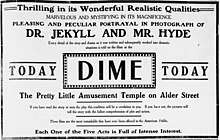Dr. Jekyll and Mr. Hyde (1908 film)
Dr. Jekyll and Mr. Hyde is a 1908 silent horror film starring Hobart Bosworth, and Betty Harte in her film debut. Directed by Otis Turner and produced by William N. Selig, this was the first film adaptation of Robert Louis Stevenson's 1886 novel Strange Case of Dr Jekyll and Mr Hyde. The screenplay was actually adapted by George F. Fish and Luella Forepaugh from their own 1897 four act stage play derived from the novel, causing a number of plot differences with the original source. Despite Stevenson's protests, this film became the model which influenced all the later film adaptations that were to come.[1]
| Dr. Jekyll and Mr. Hyde | |
|---|---|
 Newspaper advertisement | |
| Directed by | Otis Turner (unconfirmed) |
| Produced by | William N. Selig |
| Written by | George F. Fish Luella Forepaugh |
| Based on | The Strange Case of Dr Jekyll and Mr Hyde by Robert Louis Stevenson |
| Starring | Hobart Bosworth Betty Harte |
| Distributed by | Selig Polyscope Company |
Release date |
|
Running time | 16 mins. (one reel) |
| Country | United States |
| Language | Silent movie |
Roy Kinnard states it is also considered to be the first American horror film.[2] There are no known existing copies of the film today.[3]
Plot
The film begins with the raising of a stage curtain. Dr. Jekyll vows his undying love for Alice, a vicar's daughter, in her spacious garden. Suddenly, seized by his addiction to the chemical formula, Jekyll begins to convulse and distort himself into the evil Mr. Hyde. He savagely attacks Alice, and when her father tries to intervene, Mr. Hyde takes great delight in slaughtering him. While in his lawyer's office, Dr. Jekyll sees visions of himself being executed for his crime.
Hyde later visits a friend Dr. Lanyon to ask him to procure some chemicals he needs, and after drinking the potion, he transforms back into Jekyll right before the doctor's eyes. Later in his lab, Jekyll transforms back into Mr. Hyde again, but haunted by visions of the gallows, he takes a fatal dose of poison, killing both of his identities simultaneously. In true theatrical tradition, the curtain then closes.
Production
The screenplay was adapted by George F. Fish and Luella Forepaugh based on their own 1897 four act stage play, which was condensed into a 16-minute long film. Selig thought the screenplay he used was based directly on Stevenson's novel, not realizing it had been adapted from Fish and Forepaugh's stage play instead, causing some plot differences. Selig erroneously commented upon its release that his film was "presented in strict accordance with the original book....involving each detail of pose, gesture and expression.....executed by persons of indisputed dramatic ability."[4][3]
Despite its brevity, the film was also organized into four acts, just like the play.[2] Each act consisted of a single scene, and the acts were separated onscreen by the rising and falling of a curtain.Selig produced a number of films from this period in much the same way, as if a static camera had simply photographed a stage play that was in progress.[3]
The film was released seven months after the death of stage actor Richard Mansfield. (Mansfield had created the part of Jekyll/Hyde in the theater in Dr. Jekyll and Mr. Hyde, the first stage adaptation written by Thomas Russell Sullivan, beginning in 1887.)[2]
To cash in on the popularity of their 1908 film, the Selig Polyscope company released another version of the Jekyll-Hyde story (running 7 minutes) in 1909 called A Modern Dr. Jekyll, which updated the story to a contemporary setting. Jekyll's formula was depicted as more of a magic potion in that film, and even transforms him into a woman in one scene. The 1909 film is also considered lost.[3]
Critiques
Jekyll's transformation into Hyde was filmed all in one continuous shot without the use of any special effects. Bosworth simply contorted his body into a hunchbacked position and slid part of the wig he was wearing lower down over his forehead.[1] Critics were enthusiastic, giving Bosworth special mention: "The change is displayed with a dramatic ability almost beyond comprehension".
Motion Picture World opined "The successful reproduction of this well-known drama surpassed our expectations".[5]
References
- Haberman, Steve (2003). "Silent Screams". Midnight Marquee Press. p. 15. ISBN 978-1-936168-15-6
- Kinnard, Roy (1995). Horror in Silent Films. McFarland and Company Inc. p. 24. ISBN 0-7864-0036-6.
- Workman, Christopher; Howarth, Troy (2016). Tome of Terror: Horror Films of the Silent Era. Midnight Marquee Press. p. 42. ISBN 978-1936168-68-2.
- Nollen, Scott Allen (1994). Robert Louis Stevenson: Life, Literature and the Silver Screen. Jefferson, North Carolina: McFarland. p. 168. ISBN 0-89950-788-3. OCLC 473576741.
- Kinnard,Roy (1995). "Horror in Silent Films". McFarland and Company Inc. ISBN 0-7864-0036-6. Page 24.
External links
- Dr. Jekyll and Mr. Hyde at the Internet Movie Database